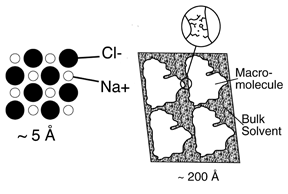The nanoporous nature of
macromolecular crystals.
Macromolecular
crystals are typically used to determined detailed
three-dimensional
structures of proteins, DNA and RNA via X-ray diffraction, which in
turn aids in understand basic mechanisms in biology.
These crystals are unique
composite materials, quite different from a conventional crystals:

Schematic comparing a salt crystal (left)
with a macromolecular crystal (right). The main difference is one of
scale. This means that in the macromolecular case the interstices
are large and filled with disordered bulk solvent. Also, in the
macromolecular case only a small fraction of the atoms are involved in
lattice contacts, which make the crystal relatively fragile.
We are studying how the disordered phase, permeating
the crystals in nanometer sized pores, confers upon the crystal
interesting physical properties. We are focusing mainly on the
cryobehavior, and have also studied diffusion through the pores,
cracking caused by osmotic processes, and the temperature dependence of
radiation damage. We are studying the relationship between the
character of each of these processes and the geometry of the nanopores.
